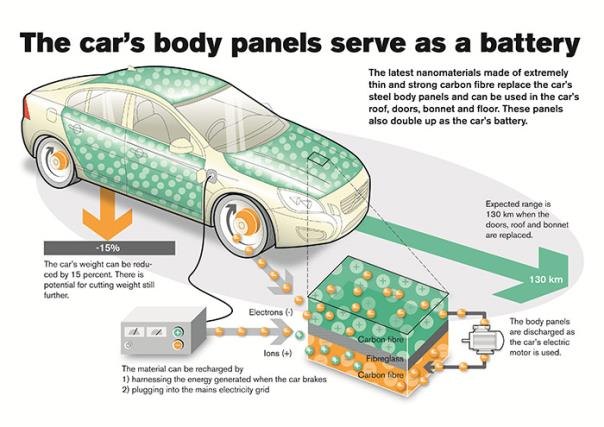Volvo Capacitive Carbon Fiber Panels Could Replace Batteries, Save Weight In EVs & Conventional Cars
That CFRP cowl panel is really storing electricity.
BMW is using carbon fiber composite unibodies for the electric i3 and i8 models to reduce their weight, thereby increasing their range. Now, Volvo is using carbon fiber in a novel way for EVs. Using carbon fiber it has developed a composite material that acts as a capacitor, storing electrical energy, so theoretically body panels and structural components could act as battery equivalents. Unlike conventional batteries, which add weight to a vehicle, the carbon fiber capacitive body panels wouldn’t just power the vehicles but also reduce weight.
To demonstrate the technology, Volvo replaced the the trunk lid, door panels, cowl, and hood of an S80 with the new composite. The panels are made of multiple layers of carbon fiber, insulated from each other with layers of fiberglass. The fiberglass acts as a dielectric with the layers of carbon fiber performing the tasks of the anode and cathode in a conventional capacitor.
Volvo estimates that replacing an EV’s entire battery pack with capacitive panels would reduce total vehicle weight by 15%. It would also help in packaging. One criticism of the Chevy Volt is that its large centrally mounted battery pack turns a five passenger platform into a four passenger car. If the car’s structure is the power source, space formerly used for batteries can be put to better use.
There are possibilities for conventional vehicles as well, with the potential to replace the heavy 12 volt starter battery with just a few capacitive carbon fiber panels.
There are possible drawbacks, including cost and safety. Carbon fiber is expensive to work with so panels would be costly to make and to replace. Also, in the event of a collision that damages the panels’ electrical safety could be a concern.
As usual, there was no world on when, or if, this technology will ever see its way to a production vehicle.
More by TTAC Staff
Latest Car Reviews
Read moreLatest Product Reviews
Read moreRecent Comments
- MaintenanceCosts Poorly packaged, oddly proportioned small CUV with an unrefined hybrid powertrain and a luxury-market price? Who wouldn't want it?
- MaintenanceCosts Who knows whether it rides or handles acceptably or whether it chews up a set of tires in 5000 miles, but we definitely know it has a "mature stance."Sounds like JUST the kind of previous owner you'd want…
- 28-Cars-Later Nissan will be very fortunate to not be in the Japanese equivalent of Chapter 11 reorganization over the next 36 months, "getting rolling" is a luxury (also, I see what you did there).
- MaintenanceCosts RAM! RAM! RAM! ...... the child in the crosswalk that you can't see over the hood of this factory-lifted beast.
- 3-On-The-Tree Yes all the Older Land Cruiser’s and samurai’s have gone up here as well. I’ve taken both vehicle ps on some pretty rough roads exploring old mine shafts etc. I bought mine right before I deployed back in 08 and got it for $4000 and also bought another that is non running for parts, got a complete engine, drive train. The mice love it unfortunately.




































Comments
Join the conversation
I will try to remember this the next time I pee on an electric car
As to the safety aspect. Carbon fiber is way stronger than steel so it stands a vastly better chance of keeping it's integrity in a collision but... it does not bend, it cracks and shatters and that would not be good. I guess they could use it internally as part of the strengthening framework they use so much now (those super thick A pillars). Exciting stuff anyhoo!